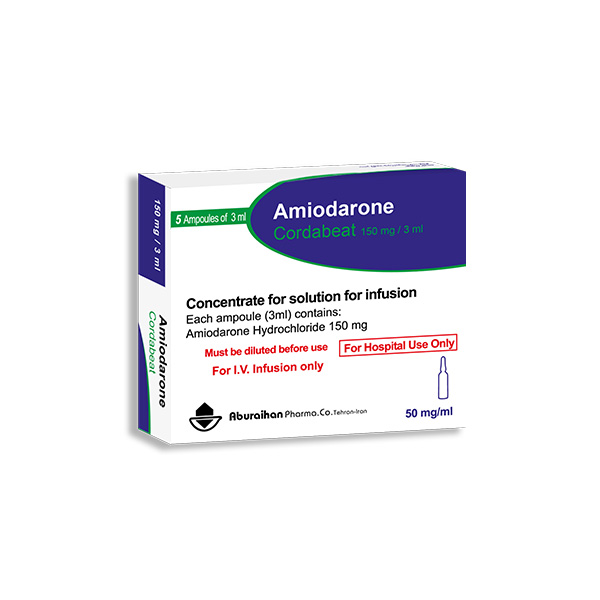Cordabeat®
Amiodarone
Amiodarone
Arrhythmias, ventricular (prophylaxis and treatment)- Amiodarone in the intravenous dosage form is indicated for the initiation of treatment (acute treatment) and prophylaxis of frequently recurring ventricular fibrillation and hemodynamically unstable ventricular tachycardia in patient’s refractory to other therapy
Mechanism of Action:
Amiodarone prolongs the action potential duration and the refractory period in all cardiac tissues (including the sinus node, atrium, atrioventricular [AV] node, and ventricle) by a direct action on the tissues, without significantly affecting the membrane potential.
Method of Administration:
Amiodarone should be administered only by physicians who are experienced in the treatment of life-threatening arrhythmias, are thoroughly familiar with the risks and benefits of amiodarone therapy, amiodarone administration be initiated in the hospital that have access to laboratory facilities equipped to adequately monitor the effectiveness and side effects of amiodarone therapy.
Notes
Usual adult dose:
Ventricular arrhythmias: The recommended starting dose of intravenous amiodarone is about 1000 mg over the first twenty-four hours.
After the first twenty-four hours-The maintenance infusion rate of 0.5 mg per minute (720 mg per twenty-four hours) should be continued, using a concentration of 1 to 6 mg per mL (concentrations greater than 2 mg per mL should be administered via a central venous catheter). The rate of the maintenance infusion may be increased to effectively achieve arrhythmia suppression.
Most patients will require therapy for forty-eight to ninety-six hours, and intravenous amiodarone may be safely administered for longer periods of time if necessary.
Contraindications:
Except under special circumstances, this medication should not be used when the following medical problems exist:
Atrioventricular (AV) block, pre-existing 2nd or 3rd degree, without pacemaker; Bradycardic episodes resulting in syncope, unless controlled by pacemaker, or Sinus node function impairment, severe, causing marked sinus bradycardia, unless controlled by pacemaker
Hypersensitivity to amiodarone.
Interactions:
Combinations containing any of the following medications, depending on the amount present, may also interact with this medication.
Anesthetics inhalation; other Antiarrhythmics; Anticoagulants, coumarin-derivative;
Beta-adrenergic blocking agents or Calcium channel blocking agents; Digitalis glycosides such as: digoxin; Diuretics, loop or Diuretics, thiazide or Indapamide; Phenytoin; other Photosensitizing medications; Sodium iodide I 123 or Sodium iodide I 131 or Sodium pertechnetate Tc 99m.
Pregnancy and Lactation:
Pregnancy Category D
Amiodarone is distributed into human breast milk. The infant receives approximately 25% of the maternal dose.
Amiodarone has been shown to cause reduced viability and growth of offspring when used in lactating rats. Mothers should be advised to contact physician before nursing, since use by nursing mothers is not recommended
Warning and Precaution:
Risk-benefit should be considered when the following medical problems exist
Congestive heart failure; Hepatic function impairment; Hypokalemia; Thyroid function impairment, including goiter or nodules
Caution is recommended also during open-heart surgery in patients receiving amiodarone because of the risk of hypotension upon discontinuation of cardiopulmonary bypass.
Adverse Reactions:
Side/adverse effects may occur even at therapeutic plasma amiodarone concentrations but are more common at concentrations over 2.5 mcg per mL and with continuous treatment for longer than 6 months. Side/adverse effects may not appear until several days, weeks, or years after initiation of amiodarone therapy and may persist for several months after withdrawal.
Storage:
Store at room temperature, between 15 and 25C (59 and 77 F).
Protect from light.
Note: Intravenous amiodarone does not need to be protected from light during administration

